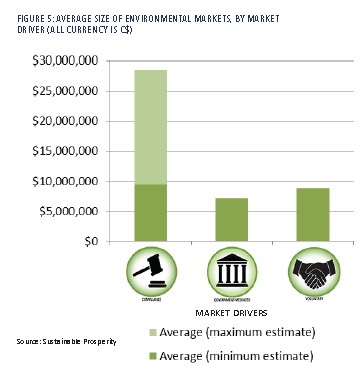Pricing Canada's Environmental Market
 Sustainable Prosperity (SP), a Canadian environmental and economic think tank, estimates that Canada’s air, water and biodiversity markets are worth between CAD $448 million and CAD $738 million annually. It’s report released last week is the first attempt of a comprehensive valuation of the total size of Canadian environmental market.
Sustainable Prosperity (SP), a Canadian environmental and economic think tank, estimates that Canada’s air, water and biodiversity markets are worth between CAD $448 million and CAD $738 million annually. It’s report released last week is the first attempt of a comprehensive valuation of the total size of Canadian environmental market.“There are more markets in air, water and biodiversity (55 markets or programs in total), and greater amounts of money changing hands in environmental markets in Canada than most people realize,” said Mike Wilson, Sustainable Prosperity’s Executive Director.
“Environmental markets are a tool that, when well-designed with the appropriate institutional and regulatory structure, can produce good outcomes for both the environment and the economy,” he added.
Estimates of environmental markets can vary widely, depending on how “environmental market” is defined. The report defines an environmental market as having a buyer (either private or public sector), a seller, and the exchange of an environmental attribute, such as greenhouse gases or endangered species habitat.
Environmental markets can deliver significant benefits to the management of natural capital, in the form of increased investment and resource stewardship, notes the report. By providing a framework through which the value of natural capital can be reflected and captured, such markets can provide a powerful incentive to their prudent management and conservation.
The report’s authors state that Canada, despite its wealth of natural capital, has traditionally been a laggard in the development and implementation of environmental markets. “This means that opportunities for the sustainable development of our natural capital have sometimes been missed, and that those measures that have been taken are more costly than they need to be,” the report states.
According to the research supporting the report, the minimum value of payments in Canadian environmental markets is estimated at between C$462 million and C$752 million annually.
Many markets are not transparent, notes the report, so this estimate, which is based on a comprehensive survey undertaken of environmental sector leaders, is an approximation. The report candidly notes there are uncertainties, and describes the methodology to clarify the assumptions in the estimations.
There is still a lot of room to expand the use of environmental markets in Canada, and to expand existing markets comcludes the study. In almost 50% of these markets, especially in water and biodiversity markets, government is the main buyer.
There is an opportunity to increase private sector involvement in these markets to help them grow, the report states, but this requires policies that enable their involvement while providing the appropriate regulatory oversight.
 “The private sector is heavily involved in compliance-driven environmental markets, such as the Western Climate Initiative, because there is policy certainty, and a strong institutional framework.” added Alex Wood, Senior Director of Policy and Markets at Sustainable Prosperity.
“The private sector is heavily involved in compliance-driven environmental markets, such as the Western Climate Initiative, because there is policy certainty, and a strong institutional framework.” added Alex Wood, Senior Director of Policy and Markets at Sustainable Prosperity. Any expansion of environmental markets requires a foundation in stable policy and strong underlying data, according to the report.
SP proposes five pillars that can help an environmental market to achieve the environmental protection it aims for: scarcity, scale, standards, social context, and stability.
These “5 S” criteria can also help policymakers to consider when an environmental market is a good solution to a problem of environmental degradation.
“Greater certainty in environmental policy and regulatory flexibility to allow for greater use of markets in Canada can help attract the necessary capital from the private sector to help expand the use of environmental markets”, he noted.
The report also outlines the role for investors, policy-makers, researchers, conservation and environmental groups, philanthropic groups and foundations and industry in developing new environmental markets, and enhancing those already in place, in Canada.
It notes that despite their significant size in terms of dollars, investors are not very active in most environmental markets, except those driven by compliance, for obvious reasons. Compliance markets provide the most security and lowest policy risk.
Although in total they may add up to significant financial sums, most of the individual markets are small and underdeveloped in terms of their infrastructure and their scope, it states. In almost half of these markets, especially in water and biodiversity markets, government is the main buyer.
You can return to the main Market News page, or press the Back button on your browser.

